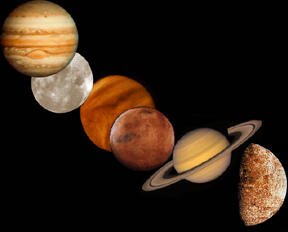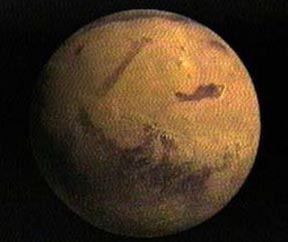3-D map of Mars
Click on image for full size
Courtesy of NASA
Scientists Create 3-D Map of Mars
News story originally written on May 28, 1999
With the help of the Mars Global Surveyor, scientists were able to create a detailed 3-dimensional map of Mars. The spacecraft took over 27 million measurements. The largest distance between measurements is 37 miles. Scientists say we know more about the surface of Mars than of Earth.
One interesting feature found on the red planet is a large basin big enough to swallow Mt. Everest. The basin, which is 6 miles deep and 1,300 miles across, is believed to have formed when an asteroid ran into the planet. Surrounding the basin is a sort of ring, made of material that was once in the basin.
However, the most important aspect of the map is the general differences between the Northern and Southern Hemispheres. The Southern Hemisphere is 3 miles higher than the Northern Hemisphere, and has many craters compared to the smooth northern half. The slope that formed between the two halves resulted in a flow of water to the upper hemisphere. The water, which may have had a volume as high as 1.2 million cubic miles, has either evaporated or been absorbed by the planet.
You might also be interested in:

It was another exciting and frustrating year for the space science program. It seemed that every step forward led to one backwards. Either way, NASA led the way to a great century of discovery. Unfortunately,
...more
The Space Shuttle Discovery lifted off from Kennedy Space Center on October 29th at 2:19 p.m. EST. The weather was great as Discovery took 8 1/2 minutes to reach orbit. This was the United States' 123rd
...more
A moon was discovered orbiting the asteroid, Eugenia. This is only the second time in history that a satellite has been seen circling an asteroid. A special mirror allowed scientists to find the moon
...more
Will Russia ever put the service module for the International Space Station in space? NASA officials want an answer from the Russian government. The necessary service module is currently waiting to be
...more
A coronal mass ejection (CME) happened on the Sun early last month. The material that was thrown out from this explosion passed the ACE spacecraft. The SWICS instrument on ACE has produced a new and very
...more
J.S. Maini of the Canadian Forest Service called forests the "heart and lungs of the world." This is because forests filter air and water pollution, absorb carbon dioxide, release oxygen, and maintain
...more
In late April through mid-May 2002, all five naked-eye planets are visible at the same time in the night sky! This is includes Mercury which is generally very hard to see. You won't want to miss this!
...more















